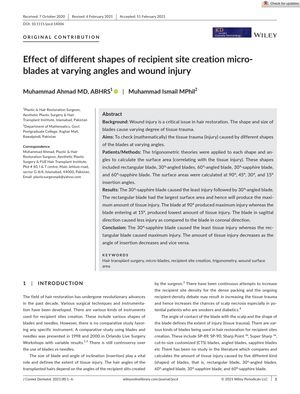Effect of Different Shapes of Recipient Site Creation Micro-Blades at Varying Angles and Wound Injury
February 2021
in “
Journal of Cosmetic Dermatology
”

TLDR Using a 30°-sapphire blade at a lower angle causes the least injury in hair transplants.
The study by Muhammad Ahmad and Muhammad Ismail used trigonometric calculations to assess tissue trauma caused by different shapes of micro-blades at various angles during hair transplant surgery. The findings indicated that the 30°-sapphire blade at a lower angle of insertion caused the least tissue injury, while the rectangular blade was the most injurious. The research suggested that using a micro-blade with a more acute angle and a smaller angle of insertion could reduce tissue trauma during hair transplants. The study was theoretical and did not involve actual patients, as it relied on mathematical modeling to reach its conclusions.




